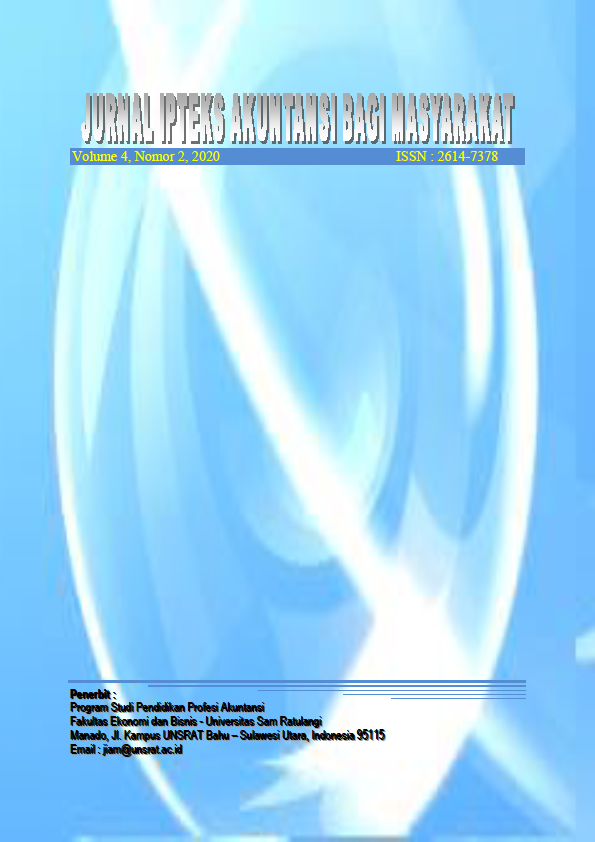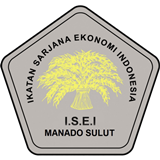IPTEKS PERHITUNGAN PENYUSUTAN DENGAN METODE GARIS LURUS DAN SALDO MENURUN PADA ASET TETAP
DOI:
https://doi.org/10.32400/jiam.4.2.2020.34121Keywords:
depreciation, declining balance method, straight-line methodAbstract
Tax is a people's contribution to the state treasury based on law (which can be enforced) with no return. Tax planning is one form of tax management function in an effort to save tax legally, one of which is by choosing a method of depreciation that can support tax efficiency. The depreciation method permitted in taxation in Indonesia consists of two methods, namely the straight-line method and the declining balance method. Both of them were used in the calculation and recognition of depreciation expense have an impact on the smaller amount of net income generated resulting in a smaller tax burden borne by the taxpayer. The application of the straight-line method helps taxpayers save tax in the years the middle of the economic period while the declining balance method helps taxpayers save tax in the early years of reporting period. This means that both the straight-line method and the declining balance method have their advantages and disadvantages.
References
Abdelkader, B., Sofiane, Mostéfaoui, S., & Zaineb, S. (2018). Taxation effect on depreciation: Evidence from the Algerian tax system. European Journal of Business Management 10(9). 85-89. https://www.iiste.org/Journals/index.php/EJBM/article/view/41483
Mardiasmo. (2018). Perpajakan. Edisi revisi tahun 2018. Yogyakarta: Andi.
Martani, D. (2012). Akuntansi keuangan menengah berbasis PSAK. Jakarta: Salemba Empat
Goni, Y. M. F. & Budiarso, N. S. (2018). Analysis calculation of depreciation fixed assets according to financial accounting standards and tax laws as well as impact on taxable income in PT. Massindo Sinar Pratama Manado. Jurnal Accountability, 7(1). https://doi.org/10.32400/ja.19072.7.01.2018.11-20.
Keating, A. S., & Zimmerman, J. L. (1999). Depreciation-policy changes: Tax, earnings management, and investment opportunity incentives. Journal of Accounting and Economics, 28(3), 359-389. https://doi.org/10.1016/S0165-4101(00)00004-5.
Kieso, D. E, Kimmel, P. D., & Weygandt, J. J. (2015) Financial Accounting, 2nd Edition. New Jersey: John Wiley & Sons, Inc.
Liapis, K. J., & Kantianis, D. D. (2015). Depreciation methods and Life Cycle Costing (LCC) methodology. Procedia Economics and Finance, 19, 314-324. https://www.sciencedirect.com/science/article/pii/S2212567115000325
Baridwan, Z. (2004). Intermediate Accounting, Edisi 8. Yogyakarta: BPFE.
Peterson, R. H. (2002). Accounting for fixed assets, 2nd Edition. New York: John Wiley and Sons, Inc.
Ratnaningsih, S. D. A., Endah, S. M. D., M. A. Ariee., & Indarto, S. L. (2014). Improving Technology Acceptance Model (TAM) for the new fixed assets Indonesian tax accounting systems. South East Asia Journal of Contemporary Business, Economics and Law,5(1). 30-37. https://seajbel.com/wp-content/uploads/2014/12/ACC-18-Improving-Technology-Acceptance-Model-TAM-for-The-New-Fixed-Assets-Indonesian-Tax-Accounting.pdf
Republik Indonesia. (2007). Undang-Undang Nomor 28 Tahun 2007 Pasal 1 tentang Ketentuan Umum dan Tata Cara Perpajakan. Jakarta.
Republik Indonesia. (2008). Undang–Undang Nomor 36 Tahun 2008 Pasal 11 tentang Pajak Penghasilan. Jakarta.
Sigidov, Y. I., Rybyantseva, M. S., & Adamenko, A. A., & Yarushkina. E. A. (2016). Methodological aspects of depreciation as an economic category. International Journal of Economics and Financial Issues, 6(S1). 88-95. https://www.econjournals.com/index.php/ijefi/issue/view/76.
Suandy, E. (2008). Hukum Pajak, Edisi 2. Jakarta: Salemba Empat.
Downloads
Additional Files
Published
Issue
Section
License
Authors who publish with this journal agree to the following terms:
- Authors retain copyright and grant the journal right of first publication with the work simultaneously licensed under a Creative Commons Attribution License that allows others to share the work with an acknowledgement of the work's authorship and initial publication in this journal.
- Authors are able to enter into separate, additional contractual arrangements for the non-exclusive distribution of the journal's published version of the work (e.g., post it to an institutional repository or publish it in a book), with an acknowledgement of its initial publication in this journal.
- Authors are permitted and encouraged to post their work online (e.g., in institutional repositories or on their website) prior to and during the submission process, as it can lead to productive exchanges, as well as earlier and greater citation of published work (See The Effect of Open Access).







